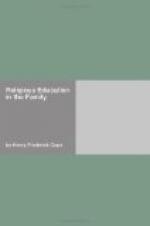Many hold that we are ready for a movement into community living, that just as the social life of the separate house porches in the villages has become communized into the amusement parks in the cities, so all the activities of the family will move in the same direction. How long could the family as a unit continue under these conditions?
The village life will persist for a long time; it may be that, when we apply scientific methods to the transportation of human beings in the same measure as we have to the moving of pig iron, we can develop large belts of real village life all around our industrial centers. But more and more the village tends to become like the city; in other words, highly organized communal life is the dominant trend today. Just as business tends to do on a large scale all that can be more economically done in larger units, so does the home. We must look for the increasing prevalence of the city type of life for men and women and for families.
Sec. 3. THE ECONOMICAL DEVELOPMENT
It is worth while to note, in some brief detail, just what changes are involved in the tendency toward communal living. At the beginning of the industrial revolution which ushered in the factory period, each family was a fairly complete unit in itself. The village was little more than a nucleus of farmhouses, with a few differing types of units, such as workers in wood, in wearing apparel, and in tools. The home furnished nearly all its own food, spun and made its clothes, trained its own children, and knew scarcely any community endeavor or any syndication of effort except in the church.
The industrial revolution took labor largely out of the home into the factory. Except for farm life, the husband became an outside worker and the older boys followed him to the distant shop or factory. Earning a living ceased to be a family act and became a social act in a larger sphere. But in this change it ceased to be a part of the family educational process. Boys who, from childhood up, had gradually learned their father’s trade in the shop or workroom, which was part of the house, where they played as children in the shavings, or watched the glowing sparks in the smithy, now missed the process of a father’s discipline and guidance as their hands acquired facility for their tasks. The home lost the male adults for from nine to twelve hours of each day, more than two-thirds of the waking period, and thus it lost a large share of disciplinary guidance. In the rise of the factory system, to a large extent the family lost the father.
When the workshop left the home its most efficient school was taken from it. The lessons may have been limited, crude, and deadly practical, but the method approximated to the ideals which modern pedagogy seeks to realize. Among the shavings children learned by doing; schooling was perfectly natural; it involved all the powers; it had the incalculable value of informality and reality. The father gone and the mother still fully occupied with her tasks, the children lost that practical training for life which home industry had afforded. On the one hand, the young became the victims of idleness and, on the other, the prey of the voracious factory system.




